Click to enlarge
IT-LI01
5 Users
IT-LI05
Activities
Configurable Options
Guidelines for Teachers, Activities and Resources
The Let's Go Series all offer a multimedia tool for interaction and discussion, either one to one or as a group learning activity. There is no age limit on the program's suitability and children and adults alike show great enthusiasm for the travels of the characters.
The series are designed as a collection of short stories that take shape as questions are asked and answered, � "Where are they going?" "What can they choose?" "What comes next?" Because the pages are passive, it is very important that staff use language and discussion with the program users whilst they interact with the program in order to gain the most from it.
Curriculum assessment and targets
Though not directly linked to any one system of measurement or assessment, the clear graphics and defined concepts in the Let's Go Series are excellent for use as part of the curriculum. EQUALS, P-LEVELS, B-Squared, PIVATS, ASDAN and other foundation stages of learning have all been taken into account when designing the programs. Special needs teachers, people working with SLD adults and Visually Impaired learners all form part of our consultancy team.
How to use each page of the story:
Each page of Let's Go To Town addresses a different place for social interaction, independence and basic skills. These are a bus stop, a post office, a fruit stall, an ice cream van, a clothes shop, a pet shop, a pedestrian crossing and a bus station. They are deliberately simple and frequently encountered storylines, designed so that each scene is already familiar to the program's users.
When using the program, first choose the scenes that you wish to tackle and set up the appropriate access levels for the user - number of switches, color and speed of scan etc. Once you have begun the stories, stop at each scene and ask lots of open questions. These might be "What can you see?" "Where are they?" What can she choose?" for example. There are also pictures of the whole town to put shops and other places in perspective. Stop at these also, as each has been designed to provide detail about where buildings and people are situated.
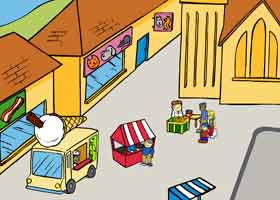
This is a good page to include as it starts the scene chronologically for the user - (as does the bus station at the end). The user must find the children and click the bus in order for them to board. There are a lot of possibilities for discussion of modes of transport. Other topics covered are concerned with choice making activities (doors, numbers, colors) and modeling the positive life skills of queuing and polite behavior.
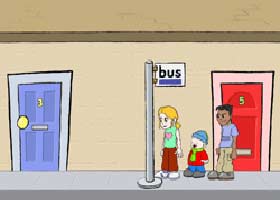
A link screen sets the context for this activity, by picturing the town square. Stop here and ask questions. "Where is the clothes shop?" "What's behind the children?" "How many people can you see?" Which other shops can you see?" The Post Office story encompasses discussion of life skills such as writing letters, buying stamps, and how to use post offices, post boxes and public telephones. You might also like to discuss the job of the postman who will walk on to collect the letters once a few have been posted!
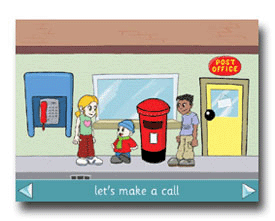
A link screen sets the context for this activity, showing the crossing from a different perspective. Ask questions about road safety and awareness. "What do the white lines mean?" "When should you cross?" "What should you press?" "What do the colors mean?" "Why are they crossing?" etc. The pelican crossing introduces the steps to traffic awareness and how to cross a road safely: what to do and in what order. See what happens when the children attempt to cross if it's not safe, and talk about it with your student(s).
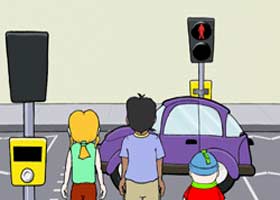
A link screen shows the children walking into the clothes shop. Talk about what's in the window. There are three different outfits that the user can choose for the girl to try on. These can prompt conversation about future and past events. "What can you wear in different seasons; on holidays; for a trip; for fashion; for a party?" You can also discuss choice, fitting, colors, preferences and who can help you to try clothes on. Life skills are also an important part of what is reinforced here. The girl shows good behavior in the shop, returns her clothes to their hangers and changes in privacy.
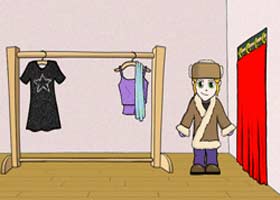
In the same shop we see the oldest boy trying on coats. This introduces some early maths language: size, shape and color, as well as more life skills - fitting clothes correctly, using a mirror, checking your appearance and reinforces good behavior in shops. You might also talk about why he would need a coat and when to wear one.
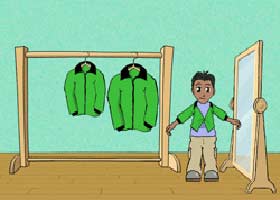
The link screen here puts you back in the town square. Ask questions of your students - "Where are they going now?" "Why is he wearing a white coat?" "What job does he do?" "Which fruit is your favorite?" The life skills that this story addresses include purchasing, choice, and interaction with different stallholders. Early maths language appears in the form of weight, how weight affects price, and counting. Try asking your student to get different amounts of fruit - "three bags of bananas and one bag of apples" for example.
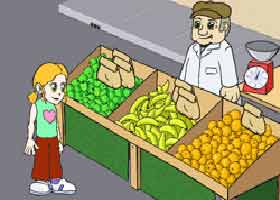
The link screen shows you another part of the town square and gives opportunity for more conversation about places. "Where have they been?" "Where can they go next?" "Which other shops can you see?" When you click the 'forwards' button you can hear the ice cream van's familiar tune. Questions in this story involve choice, shape, color, and the uniform of the different staff. Sequencing is also an important skill to realize and discuss here. "Which ice-cream would you like?" "When should you pay?" The social skills of asking, paying and general polite behavior are also modeled. (The older children help the younger one before themselves).
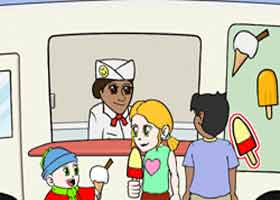
The context screen shows the children looking through the window. Stop here and ask some questions to involve your students as much as possible "Which animals do you think they can see through the window?" "What color are the cats, rabbits etc?" "Which pets do you have at home?" Inside the shop, the subjects of buying and selling and looking after animals are important. You could also look at the different properties of animals and birds "What noise do dogs make?" "Which ones have fur?" "Can you see something that swims?" Click on all the animals and the boy to see what they do.
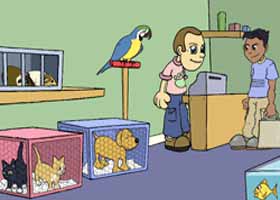
The final link screen takes the children to the bus station. Talk about what your student can see: the signs for buildings, safety barriers, bollards, and what they are for. The people at the bus stop model good behavior when they wait. Numbers and letters are used to match the right bus to its terminal. Topics you can discuss here include counting, sorting and early maths language such as empty and full, more and less. Choose a bus station and see what happens with each sequence of clicks.
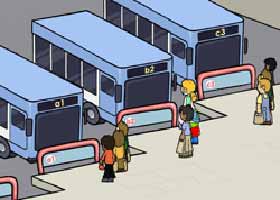
| Animals | Ice Cream | Clothes shop | Market | Post Office | Crossing |
| Bus | Ice Cream Van | Clothes | Outfit | Road | Dress |
| Bus Station | Letter | Coat | Pet Shop | Town | Fruit |
Off computer activities
Here are a few ideas for activities that the Inclusive Technology Team have come up with, though we are sure you can think of many more:
Role-playing
Choose one of the various characters seen in Let's Go To Town. Role-playing situations might involve behavior, buying items, listening and interacting. For greater imagination, play characters that are not seen but could plausibly be there - the butcher, or bus driver for example.
Worksheets and whiteboards
Worksheets can be a good memory aid to introducing or following up a trip out. You might also use the ideas of fruit, buses or ice creams for basic money work, addition, subtraction, matching and early math language.
Extensions to activities for PSHE / Citizenship
Let's Go to Town can be used in social time to talk about shopping and choice, methods of travel, survey of different methods of travel to school and preferences. You might like to use the program to talk about road safety issues. For shopping skills activities why not create your own fruit stall in class? You could use weighing scales, prices, and different characters. The bus stop story provides a base for discussing ticket purchase, using timetables, and the sequence of how to use a bus.